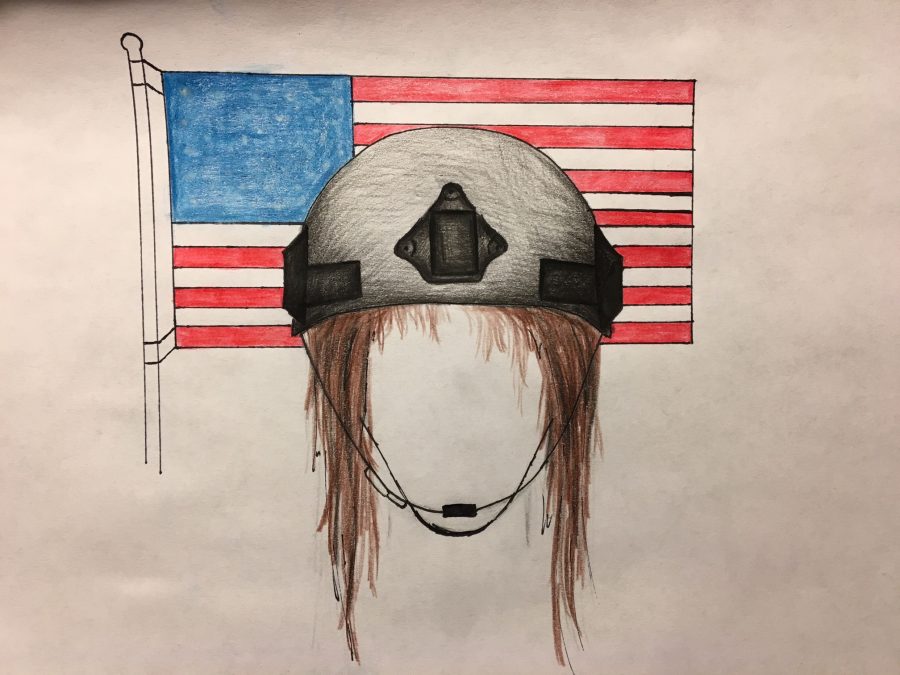Remembering the Forgotten: Women on the Front Lines
April 7, 2017
Despite popular belief, women have played an active role in the military since the birth of the United States, even if that role was previously limited to nursing and other non-combat positions.
It was only in 2016 that all U.S. Army combat and Special Forces jobs became available to women. Now, in 2017, women have the option to enlist in the same combat roles that men can. Looking ahead to the future, how will female integration into these positions affect the performance of combat units?
Initially, if women wished to engage in combat, they had to pull a Mulan-style trick: disguise themselves as men and register under male names. Still, some women, such as Deborah Samson Gannett, enlisted under a fake name and served in wars as early as the American Revolution. Other women served as spies during wartime, infiltrating enemy territory to collect valuable information for the U.S. Army.
World War II redefined the role of women in the military. Although still confined to non-combat roles, over 140,000 women served in the Women’s Army Corps. 60,000 women worked as nurses, while nearly 1,000 served as pilots. Few even secured highly selective jobs in the intelligence agency under the Allied Powers. Women shattered racial boundaries as well: Frances Wills and Harriet Pickens pioneered the Women’s Naval Reserve (commonly known as WAVES) by becoming the first black female officers in the U.S. Navy.
Hannah Wilkinson ‘17 notes that “women in World War II were amazing. In addition to supporting the manufacturing industry, they also provided vital medical care and other resources to the U.S. Army. We could not have won it without them, but they get little credit for all the work they did.”
Despite their indispensable contributions– ranging from cryptography, parachute rigging, and maintenance– women still could not engage in explicitly defined combat roles.
In years following World War II, the role of women in the military remained relatively stagnant. In both the Korean and Vietnam wars, women were restricted to non-combat positions, but still played crucial roles. Meanwhile, the nation’s workforce eventually desegregated, allowing more women of color to contribute on the homefront, even if in different ways from their male counterparts.
At the turn of the 1970s, drastic reform occurred, coinciding with the rise of the feminist movement. The first female ROTC cadets graduated in 1972, and the Army Chief of Staff found in 1975 that “female graduates met the [U.S. Army] standards in every area except the Physical Readiness Training Program.” The first gender-integrated class at military station Fort McClellan also began in 1977.
Despite this progress, women would not deploy into combat until 1991, during the Gulf War. Over 40,000 women engaged in combat, and two were taken captive. Unfortunately, this progress towards gender-integrated combat positions would be backpedaled a mere three years later, when the U.S. Defense Secretary prohibited women from “serving in units whose primary mission is to engage in direct ground combat.”
In recent years, more combat jobs have slowly opened to women. Many women also serve as engineers, intelligence officials, and other army-related jobs. However, it was only in December of 2015 that the Pentagon announced all combat jobs had to opened up to women. A holistic implementation did not occur until the later half of 2016. This controversial announcement simultaneously sparked outrage, raised concerns, and garnered praise from various groups.
The main concern among male soldiers is that their female counterparts are simply not cut out for the brutal training required to serve in combat positions. Some hypothesize that females simply lack the strength to survive on the battlefield. Proponents of integration blame sexist media, especially that of the 1950s, for putting forth frail caricatures of women. Furthermore, it is argued that although male and female bodies are built differently, it is unfair to make a blanket statement that all women are biologically incompetent. Females may struggle to pass physical milestones, but surveys reveal that the public agrees that women should nevertheless have the opportunity to try.
Many have also expressed concerns about women’s mental preparedness for combat. Some soldiers argue that women are less able to handle the severe psychological strain of war. In response, others argue that females have historically demonstrated capability and willingness to deal with the difficulties of war since the Revolution.
Perhaps the largest concern for women in the military is the high number of sexual assault incidents. A report in 2011 found that women are more likely to be raped by a fellow soldier than to be killed in combat. The Veteran’s Health Administration found that one in five women are victims of sexual assault while in service.
“The women who bravely put themselves on the line for our country face danger from the nation’s enemies, but from within the ranks as well,” muses Kina Qiu ‘17. “From everyday discrimination, to harmful judgment, to outright sabotage and sexual assault, these heroes face new problems everyday while seldom receiving the respect they deserve. Even simple things like improperly sized clothing or fitted equipment can endanger their lives, but many times women in the military are regarded with little or no respect. ” Although sexual assault rates have dropped in the past two years, it still remains a major concern.
With recent integration, it is too early to observe how combat units’ dynamics will unfold. Similar to other bipartisan issues in America, the topic accentuates on the growing disparity between traditionalism and social progressivism. Overall, women play a vital role in the military, whether in nursing, intelligence, or combat. Integration sends a powerful message to women throughout the country, reassuring that equal sacrifice deserves equal recognition.
Sources:
http://www.cnn.com/2016/11/10/us/women-combat-us-military/
http://www.motherjones.com/politics/2015/12/female-officers-break-down-myths-about-women-at-war

